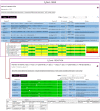Consensus and conflict cards for metabolic pathway databases
- PMID: 23803311
- PMCID: PMC3703255
- DOI: 10.1186/1752-0509-7-50
Consensus and conflict cards for metabolic pathway databases
Abstract
Background: The metabolic network of H. sapiens and many other organisms is described in multiple pathway databases. The level of agreement between these descriptions, however, has proven to be low. We can use these different descriptions to our advantage by identifying conflicting information and combining their knowledge into a single, more accurate, and more complete description. This task is, however, far from trivial.
Results: We introduce the concept of Consensus and Conflict Cards (C₂Cards) to provide concise overviews of what the databases do or do not agree on. Each card is centered at a single gene, EC number or reaction. These three complementary perspectives make it possible to distinguish disagreements on the underlying biology of a metabolic process from differences that can be explained by different decisions on how and in what detail to represent knowledge. As a proof-of-concept, we implemented C₂Cards(Human), as a web application http://www.molgenis.org/c2cards, covering five human pathway databases.
Conclusions: C₂Cards can contribute to ongoing reconciliation efforts by simplifying the identification of consensus and conflicts between pathway databases and lowering the threshold for experts to contribute. Several case studies illustrate the potential of the C₂Cards in identifying disagreements on the underlying biology of a metabolic process. The overviews may also point out controversial biological knowledge that should be subject of further research. Finally, the examples provided emphasize the importance of manual curation and the need for a broad community involvement.
Figures




Similar articles
-
Critical assessment of human metabolic pathway databases: a stepping stone for future integration.BMC Syst Biol. 2011 Oct 14;5:165. doi: 10.1186/1752-0509-5-165. BMC Syst Biol. 2011. PMID: 21999653 Free PMC article.
-
Knowledge representation in metabolic pathway databases.Brief Bioinform. 2014 May;15(3):455-70. doi: 10.1093/bib/bbs060. Epub 2012 Nov 30. Brief Bioinform. 2014. PMID: 23202525 Review.
-
Improving the description of metabolic networks: the TCA cycle as example.FASEB J. 2012 Sep;26(9):3625-36. doi: 10.1096/fj.11-203091. Epub 2012 Jun 1. FASEB J. 2012. PMID: 22661004
-
Biocuration workflows and text mining: overview of the BioCreative 2012 Workshop Track II.Database (Oxford). 2012 Nov 17;2012:bas043. doi: 10.1093/database/bas043. Print 2012. Database (Oxford). 2012. PMID: 23160416 Free PMC article.
-
Biomolecular pathway databases.Methods Mol Biol. 2010;609:129-44. doi: 10.1007/978-1-60327-241-4_8. Methods Mol Biol. 2010. PMID: 20221917 Review.
Cited by
-
Context-based resolution of semantic conflicts in biological pathways.BMC Med Inform Decis Mak. 2015;15 Suppl 1(Suppl 1):S3. doi: 10.1186/1472-6947-15-S1-S3. Epub 2015 May 20. BMC Med Inform Decis Mak. 2015. PMID: 26045143 Free PMC article.
-
Computational strategies for a system-level understanding of metabolism.Metabolites. 2014 Nov 24;4(4):1034-87. doi: 10.3390/metabo4041034. Metabolites. 2014. PMID: 25427076 Free PMC article. Review.
-
Taking Bioinformatics to Systems Medicine.Methods Mol Biol. 2016;1386:17-41. doi: 10.1007/978-1-4939-3283-2_2. Methods Mol Biol. 2016. PMID: 26677177 Free PMC article. Review.
-
A curated C. difficile strain 630 metabolic network: prediction of essential targets and inhibitors.BMC Syst Biol. 2014 Oct 15;8:117. doi: 10.1186/s12918-014-0117-z. BMC Syst Biol. 2014. PMID: 25315994 Free PMC article.
-
Prediction of drugs having opposite effects on disease genes in a directed network.BMC Syst Biol. 2016 Jan 11;10 Suppl 1(Suppl 1):2. doi: 10.1186/s12918-015-0243-2. BMC Syst Biol. 2016. PMID: 26818006 Free PMC article.
References
-
- Herrgård MJ, Swainston N, Dobson P, Dunn WB, Arga KY, Arvas M, Blüthgen N, Borger S, Costenoble R, Heinemann M. et al.A consensus yeast metabolic network reconstruction obtained from a community approach to systems biology. Nature Biotechnol. 2008;26:1155–1160. doi: 10.1038/nbt1492. - DOI - PMC - PubMed
Publication types
MeSH terms
LinkOut - more resources
Full Text Sources
Other Literature Sources
Research Materials

